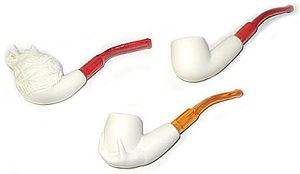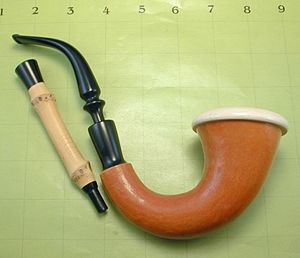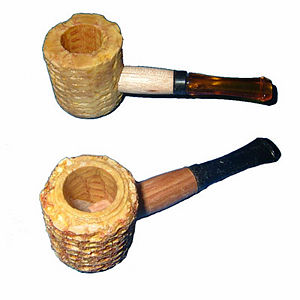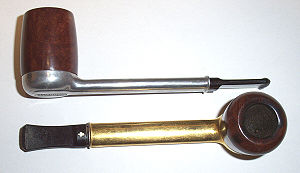Materials and Construction: Difference between revisions
Casualpiper (talk | contribs) (→'''Materials and Construction''': replaced broken link) |
|||
| Line 62: | Line 62: | ||
Corncob pipes remain popular today because they are inexpensive and require no "break-in" period like briar pipes. For these two reasons, corncob pipes are often recommended as a "Beginners pipe." But, their enjoyment is by no means limited to beginners. Corncob pipes are equally valued by both learners, and experienced smokers who simply desire a cool, clean smoke. Pipe smokers who wish to sample a wide variety of different tobaccos and blends also might keep a stock of corncobs on hand to permit them to try new flavors without "carryover" from an already-used pipe, or to keep a potentially bad tasting tobacco from adding its flavor to a more expensive or favored pipe. | Corncob pipes remain popular today because they are inexpensive and require no "break-in" period like briar pipes. For these two reasons, corncob pipes are often recommended as a "Beginners pipe." But, their enjoyment is by no means limited to beginners. Corncob pipes are equally valued by both learners, and experienced smokers who simply desire a cool, clean smoke. Pipe smokers who wish to sample a wide variety of different tobaccos and blends also might keep a stock of corncobs on hand to permit them to try new flavors without "carryover" from an already-used pipe, or to keep a potentially bad tasting tobacco from adding its flavor to a more expensive or favored pipe. | ||
---- | ----The Complete Corncob Primer | ||
While I’ve been smoking cobs for over 49 years, I’m no expert, but just maybe my dad was, and he taught me everything I know. So at the urging of Ed Anderson and John Q, I’ve decided to do my best at passing on some of dad’s knowledge. I’ll first give a run down on all the current Missouri Meerschaum models I’ve smoked. Over the years, as models have been dropped, and others added, my choice of favorites has changed, as it has recently. I’ll then go into detail on my dad’s lessons to me on the care and feeding of cobs. Both the cleaning and maintenance as well as packing, lighting, and smoking; information he began gifting me on June 1, 1959, the day he handed me a corn cob and a large tin of Carter Hall. And I’ll also give advice based on various concerns of both new pipers, and veterans new to cobs. | |||
Missouri Meerschaum brand cobs are all that I smoke, and the only ones I would advise anyone to use. Sure, I’ve tried other brands, but none had the quality of MM cobs. MM has been making cobs since 1869, and they simply are the best. You can check out their entire product line, and read their history here: http://www.corncobpipe.com/ Mars http://www.marscigars.com/index.asp?...TS&Category=24 has the best selection and prices of any e-tailer I have found, and they offer a 10% discount on dozen lots. Frenchy www.frenchyspipes.com gives cobs and supplies to our military, and still offers excellent prices and service. Most MM models come with paper filters, and I’m of the opinion that the filters only get damp and smelly. So I very strongly suggest you remove and discard them. | |||
Missouri Meerschaum does use Plaster-of-Paris and lacquer to finish their non-natural pipes, and a black stain on a few models. Usually, it doesn’t cause a problem on the inside of the bowl, but sometimes it can be a nuisance. If you notice any kind of stain inside the bowl, or just to be on the safe side, lightly use sand paper to remove anything and everything other than cob from the inside of the bowl. Some folks also sand the outside of the bowls, to make them “more natural”. Or just buy the Pride, which is natural and unfinished. | |||
Since cobs are low-cost and machine-made, with little if any finish work done to them, give them the once over before smoking them, and if needed, do some trimming with a pen knife to clear out the air way and the stem inside the bowl. There are some people who are critical of the quality of workmanship, but all but one model retails for well under $10.00, several under $3.00. So, if you accept them for what they are, I think you will find them quite the bargain. As for the wooden shank that extends inside the bowl, while some cobbers remove them, I’ve always left them, and over time, have gotten used to them. The models with hardwood plugs are no problem, but other versions will become more prone to burnout if the inner shank is removed. | |||
Cobs with paper labels don’t have hardwood bottoms. | |||
So if you decide to remove the inner portion of the shank, I’d strongly advise you to protect the bottom of the bowl with the application of “pipe mud”. Pipe Mud is a medium thick mixture of pipe tobacco ash and either saliva or water. Mix until you have a thick mud, and then apply several layers, letting each layer dry partially. Allow the cob to rest several days, so the pipe mud can cure. And now for my reviews. | |||
I finally got my first Freehand, and I have been impressed. It is a very nice pipe that delivers an excellent smoke. Maybe it is because of the tall, conical shaped bowl, which is 2 1/4“ deep, but the pipe seems to enhance the flavor of any blend I smoke in it. I have heard that the shanks can be fragile, but the bowls are quite large, and no two are alike. Although the Freehand is heavier than my other cobs, it’s very well balanced, so that the weight isn’t even noticed. The Freehand is one of the finest cobs I have smoked in over 49 years. | |||
The Diplomat has been my cob of choice for a long time, but the thicker walls that made it a real favorite was also the biggest drawback it had. The Diplomat no longer has the thick walls that I had come to appreciate. Diplomats now have standard sized bowl thickness, which isn't really a bad thing, since they are now lighter in weight and better fit my hand. | |||
I'd say the Diplomat and Country Gentleman are quite similar now; the differences being that the Diplomat has a hard wood bottom, and isn't stained dark, which is the obvious, Signature feature of the Country Gentleman. The Country Gentleman has its fans, and is a nice pipe; I just don’t care for that black stain. More about the CQ later. | |||
The Pride is an extremely nice smallish cob, and one of only a few MM models left alone, or unfinished. For that reason, it offers the dry and cool smoke every piper hopes for. I love this model, and its small size makes it ideal for quick smokes. | |||
The American General has, as do most MM cobs, a polished exterior. Some folks remove this coating, for a more natural smoke. I’m much too lazy to do that. What would make the General a favorite is that it has a tall bowl, sort of a stack, and thicker walls than the popular Country Gentleman. This to me is a near perfect cob, other than its weight. I can fill the bowl all the way and have a nice, long, relaxing 90 minute or longer experience, or I can partially fill it and enjoy a nice, shorter smoke. Although it’s less expensive than the Freehand, I would choose the Freehand over the General, personally. | |||
The Country Gentleman is popular, in part, I think because it looks funky, with that black coating it shares with the Patriot Spool. Now, some folks mention that it has a larger bowl than the Diplomat, which is true, but there is so little difference, it hardly matters. What keeps the CG from being a favorite of mine are its thin walls. It’s simply can get too warm to handle comfortably, and I’m a very slow smoker. | |||
The Patriot Spool has the same black coating that’s on the Country Gentleman, but has the added bonus of being a narrow pipe. I like that, since it takes up less room, and when you live in a small apartment, it matters. I also think a black spool looks funky. Plus it has that thicker rim, for a bit cooler place to grip the pipe. It's also a nice flake pipe. | |||
The Great Dane Egg is the only current model that isn’t a sitter, or poker style. That for me is a minor drawback. Otherwise, this is a nice cob, with thick walls and a medium sized bowl, similar to the Pride. It’s actually a cheapened version of the Bulldog, which was discontinued in 2000, and which was the last MM cob of somewhat higher quality. | |||
The Legend is a fine starter pipe, and MM’s biggest seller. It’s what most people think of when you mention corncob pipes, what with its plastic amber bit. The Legend is a small pipe, and the shape varies slightly, since it seems that few source cobs are rejected. | |||
The Pony is a small, unfiltered straight pipe. This model is a half step below the Legend in size and quality. Not a bad pipe, since I don’t feel there is a bad MM, just not the best. | |||
The Cherry Wood poker is not a cob, but it is made by MM. It’s a small, thin walled pipe, which I use for some of my flakes. It’s perfect for two of the Heinrichs Dark Strong Flakes, so no, you won’t be able to stuff a full slice of FVF in this baby, but it does its job like a champ. | |||
The Maple Wood poker is a twin of the Cherry Wood, which I find imparts a natural sweetness to any tobacco. These are excellent, low-cost flake pipes, which come either as bent or straight models. In spite of their thin walls, neither the Cherry or Maple version gets overly warm with flakes. | |||
The following MM models I have not used, and will only describe for you. | |||
The Great Dane Spool seems to be exactly the same model as the Patriot Spool reviewed above, minus the black coating. | |||
The MacArthur isn’t quite what it appears to be. Made in tribute to Douglas MacArthur, who designed the original, it looks to be and is a very tall stack cob. If you look at it closely though, you’ll notice that the stem enters the pipe fairly high, so it’s as much for show as it is for smoking. | |||
The Washington looks to be a shorter-bowled version of the General. | |||
The Mizzou is a small, unfiltered pipe that is available only as a bent shape. | |||
The Eaton seems to be a small pipe intended for new smokers, or for promotional gifting. | |||
The Miniatures are just that, undersized versions of cobs. They come either varnished or natural. | |||
The Ozark Minis are, as you might have guessed, smaller versions of the Cherry and Maple wood pokers. | |||
And now I’ll offer the advice my father gave me back in June of 1959. While I’ve learned some things on my own over the years, I still use every bit of information my dad gave me. While he did own a few briars, he much preferred smoking a cob. | |||
Using the advice offered here, your Missouri Meerschaum cob, no matter which model, should give you many years of service and satisfying smoking pleasure. In the past, I’ve had cobs last me as long as 22 years, and know folks who report over 30 years of use from a cob. With this kind of record, and the affordable cost, I don’t understand why some people will read this, and still buy either used cobs on eBay, or off-brands, which never match the quality of Missouri Meerschaum. | |||
You don't need, or in my opinion, want cake in a cob. What makes a cob so good is that it somehow first absorbs tars and strong flavors, and then dissipates them, which keeps the cob smoking fresh, if properly cleaned. Cake will not allow this to happen. Here’s the advice I offer new pipers, based on what my dad taught me back during the summer of 1959. I find it helps solve nearly every pipe smoking problem, and not just for cobs. While I smoke burley a lot more than any other tobacco, the following applies to any blend in any pipe. | |||
I dry nearly every blend that I smoke, at least a bit, and most, close to bone dry. I pack it very loose; after all these years, I just know by instinct how loose. If you think you are packing your pipe loosely, but still have issues with tongue bite, you’re probably still have it much too tight, or the tobacco is not dry enough. I don't use the tamper at all when packing. I also don't fool with a charring light, but start the tobacco burning full blast. My dad claimed that someone had told him match companies back in the mid-1700s are who invented the charring light, in order to sell more matches. And I never worry about relights; sometimes I'll need a few, sometimes none. | |||
The most important thing is smoking lazy, as I call it. Ideally, your pipe should always be on the verge of going out; that's how you extract the most taste and flavor from whatever blend you are enjoying. You should keep your cobs, and other pipes, sparkling clean. I’ll use a pipe cleaner during a smoke, if needed, and both bristle and regular cleaners after every single smoke. I use Bee Sweetener whenever needed, which is usually every couple of smokes, at the most. The time and expense needed to keep your pipes clean will pay you dividends in more flavor and enjoyment. This has worked for me for 49 years, and I've never had tongue bite. Most of what I do goes against "current thinking", which only shows that there is no one right way. | |||
After each smoke, what I do is take the pipe apart, and besides using a pipe cleaner folded in half inside the bowl; I also turn it around and use it on the shank. I use Bee Sweetener if the pipe bowl has a strong smell to it. I also use a pipe cleaner dampened with Bee Sweetener on the stem every few bowls, and then wipe off the end of the tendon. After every smoke, I use a wadded up paper towel to scrub the inside of the bowl. I also use a pipe cleaner dampened with Bee Sweetener on the rim of the bowl every other week, to get rid of tars that build up there. | |||
The biggest complaint I hear about cobs is about the plastic bits. After all these years, I’ve probably gotten used to them, since I don’t really mind them. If they are a problem for you, why not consider having better quality bits/stems made for each model MM cob you have, and switch them between cobs. At least a member or two has done this, and would share their experience if asked. Or if you decide to stay with the plastic bits, you can buy replacement bits very affordably, either from MM, or from Mars. Of course, the Freehand comes with a vulcanite bit/stem, so maybe that would solve your problem. | |||
Cobs seldom retain ghosts from any tobacco, although there are always exceptions. And just like Meerschaums, you can smoke a cob again, as soon as it has cooled. Also, cobs require much less breaking in than briars. Some people are bothered by the taste of the inner shank, but that usually goes away after 8 or 10 bowls. And make sure that you remove the paper filter that comes with most cobs, and discard it; all it does is get wet and smell bad. | |||
One of the complaints I hear about cobs is that that look seedy, but I prefer the term rustic. Another problem for some folks is how they look over time. It really shouldn’t matter, since cob exteriors don’t have a thing to do with smoking quality. But I know that looks are important, or nearly all of us would smoke nothing but cobs and basket pipes. 4 Diplomats that I got about 6 months ago are sort of special, in that I experimented with them. Some of you might remember getting a chuckle from my post about rubbing those 4 Diplomats with Aloe Vera Gel. My idea was to see if the Aloe Vera Gel would minimize the surface cracking that can happen with cobs. While the surface cracking doesn’t affect the smoking quality, it can shorten the life of a cob. | |||
Well, the Aloe Vera Gel worked like a charm. Those 4 cobs, which probably have been used 250 times each, look like they’ve only been used a month. Since those cobs were really sorry looking, I finally decided to clean them using Pledge Clean & Shine, Orange scent, Anti-Dust Formula. The difference is like night and day. Of course they don’t look spanking brand new, but they do look fashionable enough to take with me if I need a pipe for my infrequent travels. They now look well seasoned, but no longer so gross they embarrass me. As a bonus, they smell good too, at least on the outside. So if you have a few cobs that look ready for the trash heap, I suggest you grab a can of furnisher polish. | |||
Cobs aren’t going to be for everyone. But if you keep an open mind, and follow the advice offered here, you might be surprised. I hope this helps you enjoy your cobs, and any other pipes, a bit more. | |||
tiltjlp | |||
=== Metal Pipes === | === Metal Pipes === | ||
Revision as of 11:22, 22 November 2008
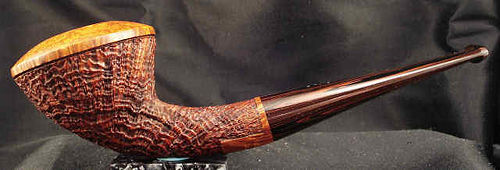
Materials and Construction
The material and shape of a pipe has a profound influence upon the aesthetics and smoking qualities. Tobacco pipes come in many shapes and styles. For an excellent chart showing classic pipe shapes, see the chart by Bill Burney: Pipe Shapes. To see an excellent chart showing pipe parts along with their names, also by Bill Burney, see Pipe Parts.
The basis for this section is from the Wikipedia entry Smoking Pipe (tobacco).
A Comprehensive list of Pipe maker materials suppliers can be found here: Materials and Supplies
Briar
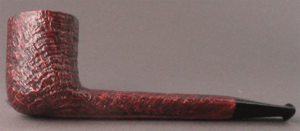
The majority of pipes sold today, whether hand made or machine made, are fashioned from briar. Briar is a particularly good wood for pipe making for a number of reasons. The first and most important is its natural resistance to fire. The second is its inherent ability to absorb moisture. The burl absorbs water in nature to supply the tree in the dry times and likewise will absorb the moisture that is a byproduct of combustion. Briar is cut from the root burl of the heath tree (Erica arborea), which is native to the rocky and sandy soils of the Mediterranean region. Briar burls are cut into two types of blocks; ebauchon and plateaux. Ebauchon is taken from the heart of the burl while plateaux is taken from the outer part of the burl. While both types of blocks can produce pipes of the highest quality, most artisan pipe makers prefer to use plateaux because of its superior graining.
- Characteristics Of Briar is a very thorough and interesting research paper in .pdf format by G. Tsoumis, N. Kezos, I Fanariotou, E. Voulgaridis, and C. Passialis documenting the various characteristics of briar.
- See, My Visit to A Briar Sawmill, What Makes a Good Briar Pipe, The Art of Sandblasting, and Curing all excellent articles by R.D. Field. Also see 100 Year Old Briar?. Also Trever Talbert's excellent blog posts[1] Sandblasting - Circles and Shanks and How to Read your Sandblast.
- R.C. Hamlin has also written an interesting article on this subject called The Briar Factor.
- So you think you're a "Briar Afficionado"? This is a short but extremely informative article by Rainer Barbi available here: The Briar Saga Page 1 & The Briar Saga Page 2.
Alternative Woods Used For Pipe making
Although briar pipes are by far the most popular, various other woods are also used by pipe makers. See Alternative Woods Used For Pipe making for a list of the many wood types and examples of pipes made with these woods. Many thanks to pipe maker Elie for suggesting this section. Also see Pipes in Other Woods an article written for The Collector by Tim Fuller
Meerschaum
Meerschaum (hydrated magnesium silicate), a mineral found in small shallow deposits mainly around the city of Eskişehir in central Turkey, is prized for its plasticity which allows it to be carved into many decorative and figural shapes. It was used as early as the 17th century in Turkey in the production of various utilitarian articles, but the first use as a pipe was not earlier than, according to translated documents, about 1725-1750. Along with clay, meerschaum represented the other common medium for pipes before the introduction of briar as the material of choice in the mid-19th century. See Antique Meerschaum Pipes.
The word "meerschaum" means "sea foam" in German, alluding to its natural white color and its surprisingly low weight. Meerschaum is a very porous mineral that absorbs elements of the tobacco during the smoking process, and gradually changes color to a golden brown. Old, well-smoked meerschaum pipes are prized for their distinctive coloring.
In selecting a meerschaum pipe it is advisable to determine if the pipe is indeed carved from a block of meerschaum, and is not made from meerschaum dust collected after carving and mixed with an emulsifier then pressed into a pipe shape. These products are not absorbent, do not color, and lack the smoking quality of the block carved pipe. It is not always obvious. Some collectors believe that some pipes marked "solid block meerschaum" may not be genuine. With no uniform grading authority, it is difficult to be sure in the case of an unknown maker, unless you are purchasing it from a trusted, well informed tobacconist. Be wary of inexpensive pipes from untrusted sources. Also look for the quality of the carving. Better carvers are unlikely to waste time carving composite meerschaum.
Clay
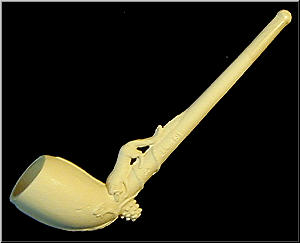
Clay in this case is almost always a very fine white clay. Low-quality "clay" pipes are actually made from porcelain forming techniques known as slip, and poured into a mold. These are porous, of very low quality, and impart unwanted flavors to a smoke. Top-notch clays, on the other hand are made in a labor-intensive process that requires beating all air out of the clay, hand-rolling each pipe before molding it, piercing with a fine wire, and careful firing. Traditionally, clay pipes are unglazed. Clays burn "hot" in comparison to other types of pipes, so they are often difficult for most pipe-smokers to use. Their proponents claim that, unlike other materials, a well-made clay pipe gives a "pure" smoke, with no flavor addition from the pipe bowl. In addition to aficionados, reproductions of historical clay styles are used by some Historical re-enactors. Clay pipes were once considered disposable items and the large quantities discarded in the past are often used as an aid in dating by industrial archaeologists.
For additional information see, A Short History Of Clay Pipes, by Heather Coleman
Calabash
Calabash gourds (usually with meerschaum or porcelain bowls set inside them) have long made prized pipes, but they are labour-intensive and nowadays quite expensive. Because of this expense, pipes with bodies made of wood (usually mahogany) instead of gourd, but the same classic shape are sold as calabashes. Both wood and gourd pipes are functionally the same. They both have an air chamber beneath the bowl which serves to cool, dry, and mellow the smoke. There are also briar pipes being sold as calabashes. These typically do not have an air chamber and are named only because of their external shape.
The construction of a calabash pipe generally consists of a downward curve that ends with an upcurve where the bowl sits. This low center of gravity allows for the user to easily hold the pipe by the mouth alone, leaving his hands free. This advantage was often used by actors who wanted to depict their character smoking while permitting them to do other business simultaneously. That is why the character Sherlock Holmes, who never used this kind of pipe in the stories, is stereotypically depicted as favoring it because early dramatic productions, especially those starring William Gillette and Basil Rathbone, made this artistic decision. In fact, Holmes, who preferred very harsh tobacco, would probably have disliked the calabash because of the above-mentioned mellowing effect.
Gourds specifically intended for pipemaking are usually "hand trained" while they are still green & growing. Every few days, after the fruit has begun to develop, the grower will bend the "neck" of the gourd, until it has formed into a near semi-circle. These are mainly grown in South Africa.
Family: Cucurbitaceae (koo-ker-bih-TAY-see-ay); Genus: Lagenaria (lag-en-AR-ee-uh); Species: Siceraria (sy-ker-AR-ee-uh); Cultivar: Dipper(?)
Calabash Interpretations: Also popular with some collectors are Calabash shaped briar pipes, or Calabash interpretations. Fred Heim has written an interesting article on collecting these called Calabash, Calabash, Wherefore Art Thou Calabash?, The Genesis of a Collecting Motif By Fred Heim, with photography by Joe Harb.
Corncob
On the other end of the scale, "corncob" pipes made from maize cobs are cheap and effective, even if some regard them as inelegant. The cobs are first dried for two years. Then they are hollowed out to make a bowl shape. The bowls are dipped in a plaster-based mixture and varnished or lacquered on the outside. Shanks made from pine wood are then inserted into the bowls. The first and largest manufacturer of corncob pipes is Missouri Meerschaum, located in Washington, Missouri in the United States.[2]. Missouri Meerschaum has produced the pipes since 1869. General Douglas MacArthur and George Lincoln Rockwell were perhaps the most famous smokers of this type of pipe, along with the cartoon characters Popeye and Frosty the Snowman.
Corncob pipes remain popular today because they are inexpensive and require no "break-in" period like briar pipes. For these two reasons, corncob pipes are often recommended as a "Beginners pipe." But, their enjoyment is by no means limited to beginners. Corncob pipes are equally valued by both learners, and experienced smokers who simply desire a cool, clean smoke. Pipe smokers who wish to sample a wide variety of different tobaccos and blends also might keep a stock of corncobs on hand to permit them to try new flavors without "carryover" from an already-used pipe, or to keep a potentially bad tasting tobacco from adding its flavor to a more expensive or favored pipe.
The Complete Corncob Primer
While I’ve been smoking cobs for over 49 years, I’m no expert, but just maybe my dad was, and he taught me everything I know. So at the urging of Ed Anderson and John Q, I’ve decided to do my best at passing on some of dad’s knowledge. I’ll first give a run down on all the current Missouri Meerschaum models I’ve smoked. Over the years, as models have been dropped, and others added, my choice of favorites has changed, as it has recently. I’ll then go into detail on my dad’s lessons to me on the care and feeding of cobs. Both the cleaning and maintenance as well as packing, lighting, and smoking; information he began gifting me on June 1, 1959, the day he handed me a corn cob and a large tin of Carter Hall. And I’ll also give advice based on various concerns of both new pipers, and veterans new to cobs.
Missouri Meerschaum brand cobs are all that I smoke, and the only ones I would advise anyone to use. Sure, I’ve tried other brands, but none had the quality of MM cobs. MM has been making cobs since 1869, and they simply are the best. You can check out their entire product line, and read their history here: http://www.corncobpipe.com/ Mars http://www.marscigars.com/index.asp?...TS&Category=24 has the best selection and prices of any e-tailer I have found, and they offer a 10% discount on dozen lots. Frenchy www.frenchyspipes.com gives cobs and supplies to our military, and still offers excellent prices and service. Most MM models come with paper filters, and I’m of the opinion that the filters only get damp and smelly. So I very strongly suggest you remove and discard them.
Missouri Meerschaum does use Plaster-of-Paris and lacquer to finish their non-natural pipes, and a black stain on a few models. Usually, it doesn’t cause a problem on the inside of the bowl, but sometimes it can be a nuisance. If you notice any kind of stain inside the bowl, or just to be on the safe side, lightly use sand paper to remove anything and everything other than cob from the inside of the bowl. Some folks also sand the outside of the bowls, to make them “more natural”. Or just buy the Pride, which is natural and unfinished.
Since cobs are low-cost and machine-made, with little if any finish work done to them, give them the once over before smoking them, and if needed, do some trimming with a pen knife to clear out the air way and the stem inside the bowl. There are some people who are critical of the quality of workmanship, but all but one model retails for well under $10.00, several under $3.00. So, if you accept them for what they are, I think you will find them quite the bargain. As for the wooden shank that extends inside the bowl, while some cobbers remove them, I’ve always left them, and over time, have gotten used to them. The models with hardwood plugs are no problem, but other versions will become more prone to burnout if the inner shank is removed. Cobs with paper labels don’t have hardwood bottoms.
So if you decide to remove the inner portion of the shank, I’d strongly advise you to protect the bottom of the bowl with the application of “pipe mud”. Pipe Mud is a medium thick mixture of pipe tobacco ash and either saliva or water. Mix until you have a thick mud, and then apply several layers, letting each layer dry partially. Allow the cob to rest several days, so the pipe mud can cure. And now for my reviews.
I finally got my first Freehand, and I have been impressed. It is a very nice pipe that delivers an excellent smoke. Maybe it is because of the tall, conical shaped bowl, which is 2 1/4“ deep, but the pipe seems to enhance the flavor of any blend I smoke in it. I have heard that the shanks can be fragile, but the bowls are quite large, and no two are alike. Although the Freehand is heavier than my other cobs, it’s very well balanced, so that the weight isn’t even noticed. The Freehand is one of the finest cobs I have smoked in over 49 years.
The Diplomat has been my cob of choice for a long time, but the thicker walls that made it a real favorite was also the biggest drawback it had. The Diplomat no longer has the thick walls that I had come to appreciate. Diplomats now have standard sized bowl thickness, which isn't really a bad thing, since they are now lighter in weight and better fit my hand.
I'd say the Diplomat and Country Gentleman are quite similar now; the differences being that the Diplomat has a hard wood bottom, and isn't stained dark, which is the obvious, Signature feature of the Country Gentleman. The Country Gentleman has its fans, and is a nice pipe; I just don’t care for that black stain. More about the CQ later.
The Pride is an extremely nice smallish cob, and one of only a few MM models left alone, or unfinished. For that reason, it offers the dry and cool smoke every piper hopes for. I love this model, and its small size makes it ideal for quick smokes.
The American General has, as do most MM cobs, a polished exterior. Some folks remove this coating, for a more natural smoke. I’m much too lazy to do that. What would make the General a favorite is that it has a tall bowl, sort of a stack, and thicker walls than the popular Country Gentleman. This to me is a near perfect cob, other than its weight. I can fill the bowl all the way and have a nice, long, relaxing 90 minute or longer experience, or I can partially fill it and enjoy a nice, shorter smoke. Although it’s less expensive than the Freehand, I would choose the Freehand over the General, personally.
The Country Gentleman is popular, in part, I think because it looks funky, with that black coating it shares with the Patriot Spool. Now, some folks mention that it has a larger bowl than the Diplomat, which is true, but there is so little difference, it hardly matters. What keeps the CG from being a favorite of mine are its thin walls. It’s simply can get too warm to handle comfortably, and I’m a very slow smoker.
The Patriot Spool has the same black coating that’s on the Country Gentleman, but has the added bonus of being a narrow pipe. I like that, since it takes up less room, and when you live in a small apartment, it matters. I also think a black spool looks funky. Plus it has that thicker rim, for a bit cooler place to grip the pipe. It's also a nice flake pipe.
The Great Dane Egg is the only current model that isn’t a sitter, or poker style. That for me is a minor drawback. Otherwise, this is a nice cob, with thick walls and a medium sized bowl, similar to the Pride. It’s actually a cheapened version of the Bulldog, which was discontinued in 2000, and which was the last MM cob of somewhat higher quality.
The Legend is a fine starter pipe, and MM’s biggest seller. It’s what most people think of when you mention corncob pipes, what with its plastic amber bit. The Legend is a small pipe, and the shape varies slightly, since it seems that few source cobs are rejected.
The Pony is a small, unfiltered straight pipe. This model is a half step below the Legend in size and quality. Not a bad pipe, since I don’t feel there is a bad MM, just not the best.
The Cherry Wood poker is not a cob, but it is made by MM. It’s a small, thin walled pipe, which I use for some of my flakes. It’s perfect for two of the Heinrichs Dark Strong Flakes, so no, you won’t be able to stuff a full slice of FVF in this baby, but it does its job like a champ.
The Maple Wood poker is a twin of the Cherry Wood, which I find imparts a natural sweetness to any tobacco. These are excellent, low-cost flake pipes, which come either as bent or straight models. In spite of their thin walls, neither the Cherry or Maple version gets overly warm with flakes.
The following MM models I have not used, and will only describe for you.
The Great Dane Spool seems to be exactly the same model as the Patriot Spool reviewed above, minus the black coating.
The MacArthur isn’t quite what it appears to be. Made in tribute to Douglas MacArthur, who designed the original, it looks to be and is a very tall stack cob. If you look at it closely though, you’ll notice that the stem enters the pipe fairly high, so it’s as much for show as it is for smoking.
The Washington looks to be a shorter-bowled version of the General.
The Mizzou is a small, unfiltered pipe that is available only as a bent shape.
The Eaton seems to be a small pipe intended for new smokers, or for promotional gifting.
The Miniatures are just that, undersized versions of cobs. They come either varnished or natural.
The Ozark Minis are, as you might have guessed, smaller versions of the Cherry and Maple wood pokers.
And now I’ll offer the advice my father gave me back in June of 1959. While I’ve learned some things on my own over the years, I still use every bit of information my dad gave me. While he did own a few briars, he much preferred smoking a cob.
Using the advice offered here, your Missouri Meerschaum cob, no matter which model, should give you many years of service and satisfying smoking pleasure. In the past, I’ve had cobs last me as long as 22 years, and know folks who report over 30 years of use from a cob. With this kind of record, and the affordable cost, I don’t understand why some people will read this, and still buy either used cobs on eBay, or off-brands, which never match the quality of Missouri Meerschaum.
You don't need, or in my opinion, want cake in a cob. What makes a cob so good is that it somehow first absorbs tars and strong flavors, and then dissipates them, which keeps the cob smoking fresh, if properly cleaned. Cake will not allow this to happen. Here’s the advice I offer new pipers, based on what my dad taught me back during the summer of 1959. I find it helps solve nearly every pipe smoking problem, and not just for cobs. While I smoke burley a lot more than any other tobacco, the following applies to any blend in any pipe.
I dry nearly every blend that I smoke, at least a bit, and most, close to bone dry. I pack it very loose; after all these years, I just know by instinct how loose. If you think you are packing your pipe loosely, but still have issues with tongue bite, you’re probably still have it much too tight, or the tobacco is not dry enough. I don't use the tamper at all when packing. I also don't fool with a charring light, but start the tobacco burning full blast. My dad claimed that someone had told him match companies back in the mid-1700s are who invented the charring light, in order to sell more matches. And I never worry about relights; sometimes I'll need a few, sometimes none.
The most important thing is smoking lazy, as I call it. Ideally, your pipe should always be on the verge of going out; that's how you extract the most taste and flavor from whatever blend you are enjoying. You should keep your cobs, and other pipes, sparkling clean. I’ll use a pipe cleaner during a smoke, if needed, and both bristle and regular cleaners after every single smoke. I use Bee Sweetener whenever needed, which is usually every couple of smokes, at the most. The time and expense needed to keep your pipes clean will pay you dividends in more flavor and enjoyment. This has worked for me for 49 years, and I've never had tongue bite. Most of what I do goes against "current thinking", which only shows that there is no one right way.
After each smoke, what I do is take the pipe apart, and besides using a pipe cleaner folded in half inside the bowl; I also turn it around and use it on the shank. I use Bee Sweetener if the pipe bowl has a strong smell to it. I also use a pipe cleaner dampened with Bee Sweetener on the stem every few bowls, and then wipe off the end of the tendon. After every smoke, I use a wadded up paper towel to scrub the inside of the bowl. I also use a pipe cleaner dampened with Bee Sweetener on the rim of the bowl every other week, to get rid of tars that build up there.
The biggest complaint I hear about cobs is about the plastic bits. After all these years, I’ve probably gotten used to them, since I don’t really mind them. If they are a problem for you, why not consider having better quality bits/stems made for each model MM cob you have, and switch them between cobs. At least a member or two has done this, and would share their experience if asked. Or if you decide to stay with the plastic bits, you can buy replacement bits very affordably, either from MM, or from Mars. Of course, the Freehand comes with a vulcanite bit/stem, so maybe that would solve your problem.
Cobs seldom retain ghosts from any tobacco, although there are always exceptions. And just like Meerschaums, you can smoke a cob again, as soon as it has cooled. Also, cobs require much less breaking in than briars. Some people are bothered by the taste of the inner shank, but that usually goes away after 8 or 10 bowls. And make sure that you remove the paper filter that comes with most cobs, and discard it; all it does is get wet and smell bad.
One of the complaints I hear about cobs is that that look seedy, but I prefer the term rustic. Another problem for some folks is how they look over time. It really shouldn’t matter, since cob exteriors don’t have a thing to do with smoking quality. But I know that looks are important, or nearly all of us would smoke nothing but cobs and basket pipes. 4 Diplomats that I got about 6 months ago are sort of special, in that I experimented with them. Some of you might remember getting a chuckle from my post about rubbing those 4 Diplomats with Aloe Vera Gel. My idea was to see if the Aloe Vera Gel would minimize the surface cracking that can happen with cobs. While the surface cracking doesn’t affect the smoking quality, it can shorten the life of a cob.
Well, the Aloe Vera Gel worked like a charm. Those 4 cobs, which probably have been used 250 times each, look like they’ve only been used a month. Since those cobs were really sorry looking, I finally decided to clean them using Pledge Clean & Shine, Orange scent, Anti-Dust Formula. The difference is like night and day. Of course they don’t look spanking brand new, but they do look fashionable enough to take with me if I need a pipe for my infrequent travels. They now look well seasoned, but no longer so gross they embarrass me. As a bonus, they smell good too, at least on the outside. So if you have a few cobs that look ready for the trash heap, I suggest you grab a can of furnisher polish.
Cobs aren’t going to be for everyone. But if you keep an open mind, and follow the advice offered here, you might be surprised. I hope this helps you enjoy your cobs, and any other pipes, a bit more.
tiltjlp
Metal Pipes
An excellent website devoted to metal pipes: Smoking Metal.
Includes various Falcon aluminum-stem pipes, plus Kirsten, Yello Bole, Dr. Grabow (Viking) and many others.
An interesting book on the subject: Back From The Ashes, Uncovering The Lost History Of G. L. Hunt and the Falcon Pipe, by K. A. Worth ~ Winner, 2008 Illinois Historical Society Book Award. Available from the author: Worthy Works Press and at Amazon: Amazon.com. For more info. see Books/Publications page...
Build your own custom Kirsten Metal Pipe at Kirsten Pipe Company
Kirsten Pipe Company - An article by Dave Whitney
